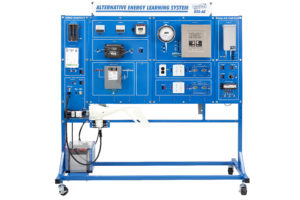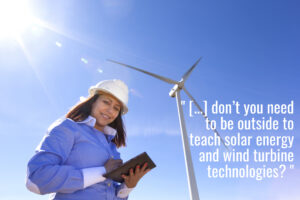Green energy employment opportunities continue to expand, and as such, Wind Energy technician roles have become increasingly attractive to students and job-seekers. Government policies announced before and during the COP26 Climate Change Conference have caused forecasters to anticipate global renewable electricity capacity to rise more than 60% from 2020 levels to over

4800 GW [By 2026] – equivalent to the current total global power capacity of fossil fuels and nuclear combined, according to iea.org. The US government states that; ‘more wind energy was installed in 2020 than any other energy source, accounting for 42% of new U.S. capacity. The U.S. wind industry supports 116,800 jobs’. In addition new turbines installed on existing towers and foundations, known as Small Wind Retrofits, account for 80% of small wind capacity installed in 2020. The federal focus on green energy in tandem with falling wind turbine prices make this an attractive sector for businesses and those looking for employment. Anyone looking for a role as a wind energy technician must possess a unique combination of basic to advanced skills in a variety of disciplines, as well as specific skills directly related to the latest alternative energy technologies.
Amatrol has developed a Wind Turbine Technology program with a comprehensive skills sequence that routes the learner from basic core skills, through advanced core skills, and wind turbine technology skills. Our wind training systems teach learners everything from the basics, like wind concepts, to advanced turbine electric hub, nacelle, and generator control troubleshooting. Using Amatrol’s unique computer-based fault insertion tool, FaultPro, allows instructors to create challenging situations that teach realistic industry troubleshooting skills.
The Pathway
Getting things started, what are the fundamentals that your students need when they’re hoping for a career as a wind technician? Although some wind technicians are involved in building new wind turbines, most of their work is maintaining, troubleshooting, and repairing them – particularly the nacelles—which contain the equipment that generates electricity. Anyone beginning their journey to become a wind technician will need a solid understanding of the fundamental concepts of AC and DC electrical systems and how electricity is used for power and control in industrial, commercial, agricultural, and residential applications. Technicians require a comprehensive understanding of a variety of measurement topics, including: digital and dial calipers; dimensional gauging; statistical process control; control chart operation and analysis; geometric dimensioning and tolerancing; and location, orientation, and form tolerances. Amatrol’s measurement tools training system includes all this plus industrial-quality components, such as a tabletop workstation, measurement tools like digital and dial calipers, variable length shafts and diameter disks, and interactive multimedia curriculum! Turbine/Nacelle maintenance requires absolute precision, and as such a technician should be able to fluently read prints. A print is a copy of a technical drawing used in the show, or at a worksite. These prints communicate the information from engineers and designers for creating, repairing, or troubleshooting parts and assemblies to the people who will perform these tasks. They can be simple drawings used to specify the stock size (i.e. dimensions of a raw material) to use in creating a part, or very complex drawings of assembled products.
 Proceeding With Specificity
Proceeding With Specificity
Amatrol has dedicated wind energy learning systems, that focus your skills and supply you with the relevant technical knowledge to fulfill your educational requirements as a Wind Tech with a specificity that goes beyond the rudimentary education.

A common issue many instructors have when beginning an alternative energy training program is location. After all, don’t you need to be outside to teach solar energy and wind turbine technologies? Fortunately, the answer is no. With Amatrol’s 850-AEW trainer, alternative energy training can occur both indoors and outdoors. This small wind learning system covers invaluable topics including: Safety, Wind Turbine Operation, Wind Turbine Performance, Wind Turbine Connection, Wind Batteries, Charge Controllers, Inverters, Balance of System Components, AC/DC Wind Systems, Energy Conservation, and Demand and System Performance. Coupling with Amatrol’s 950-WC1 multimedia course is a fantastic method for introducing wind concepts to potential wind technicians. To further bolster your alternative energy training, this system can be supplemented to include Solar expansions systems, 85-SE and 85-GT.
Honing In On The Concepts
Amatrol has a range of Utility Scale Wind Technology learning systems. Used standalone or as an interconnected network, students can get hands-on experience with nacelle and turbine control. Our Wind Turbine Technology technician training prepares Wind Turbine Technicians to confidently assess and remedy the many challenges they will face on-the-job. Troubleshooting and problem-solving across all the technologies required for Wind Turbine Technicians are keystones for Amatrol’s Wind Turbine Technology technician training program.
Available wind energy training resources include:

- Wind Concepts Learning System (950-WC1)
- Turbine Electric Hub Troubleshooting Learning System (950-TEH1)
- Turbine Nacelle Troubleshooting Learning System (950-TNC1)
- Turbine Generator Control Troubleshooting Learning System (950-TGC1)
Reach out to us, we’re here to help you offer the best learning tools at any level!





